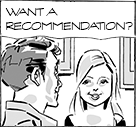Page 45 Review by Stephen
Riddled with wit and bursting with as much mischief and behavioural insight as any Kyle Baker book, this collection of short strips and cartoons is exactly the sort of masterclass in style and colour that you'd expect from the king of comics-orientated logo design.
You aren't a number, of course.
But even the most anti-authoritarian among you might be surprised at how quick we are to fall into line, and how disconcerted many become when the boundaries by which we seemingly seek to define ourselves blur, such is our obsession with hierarchy: how we rank others, how we rate ourselves, how we conform and kowtow to this constriction - consciously or subconsciously - and the ways in which we might choose to hop ahead of our given lot by making the most of what we've got.
Before really getting to satirical grips with our social ticks, Hughes begins with a relatively simple, linear demonstration with passengers sat on a bus, each wearing a brightly coloured, numbered onesie. The bloke bearing the highest ranking Number 4 demands the front seat, pushing poor 25 towards the back. Number 25 takes it out on Number 27 and so on. After all this upheaval, the story ends on an ellipsis as a bus stop is approached where waits Number 3.
I suspect that Number 37 will shortly be roused roughly from his sleep in order to stand, and while we don't see the driver's number, I bet you anything you like that it's a long one.
This is immediately followed by a cartoon of a clothes rack hanging with similarly numbered garments, emphasising the implication, in case you missed it, that this hierarchy is by no means a natural order and can be subject to change if we have the means and / or a mind to. Plenty of that will follow in the form of literary allusions, a burning of bras, and a wealthy Starlet being fitted out in a glamorous green frock adorned with a snazzy 29 by Assistant 189 and photographed by Paparazzi 311 and 512, before we flash back to the garment being fashioned by a tired and fretful 13029 in a rat-infested sweatshop.
There's one particularly poignant piece in which three kids splash happily in the mud together as naked and equal as the day they were born. Once clothes are imposed with their attendant numbers by a parent, however...
Speaking of equality, what a noble sentiment and disastrous social experiment was communism! And how rank with hypocrisy it was from the very beginning! No numbers there: instead the despot du jour proudly presides over a parade of minions obediently marching below, all of them decked out in uniforms "=" and identical to their beneficent Chairman's. No numbers, he proclaims from on high, because everyone is is "="!
On the next page he is seen waited on, hand and foot, while he watches Starlet 29 on widescreen TV. Outside the palace the clothes remain the same, but the circumstances are not so similar.
Entirely silent except for symbols, the economy of communication matches its universality, at least to those who understand Western Arabic numerals. Hughes has studied them in such depth that he has even found multiple ways to surprise us with their physical properties - their lines of symmetry, for example - when holding a mirror up to our self-esteem or the calculated connivances of those who would pull the woollen jumper over our eyes.
It always boils down to the numbers but, with a whole lot of lateral thinking, Hughes has managed to mine them for all their worth by deploying them in such different contexts that a trip to the beauty parlour results in a very different sort of make-over, and even a man in meditation, startled to hit the Buddhist jackpot, finds himself embarking on a subsequent search for further answers which may enlighten you both.

